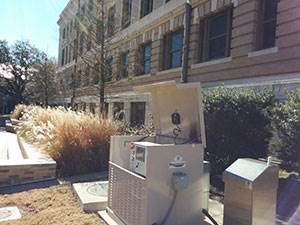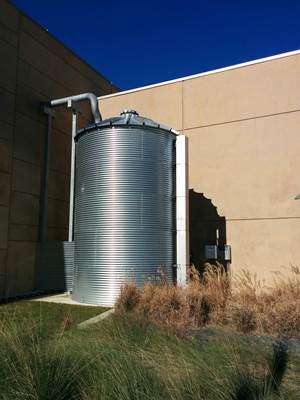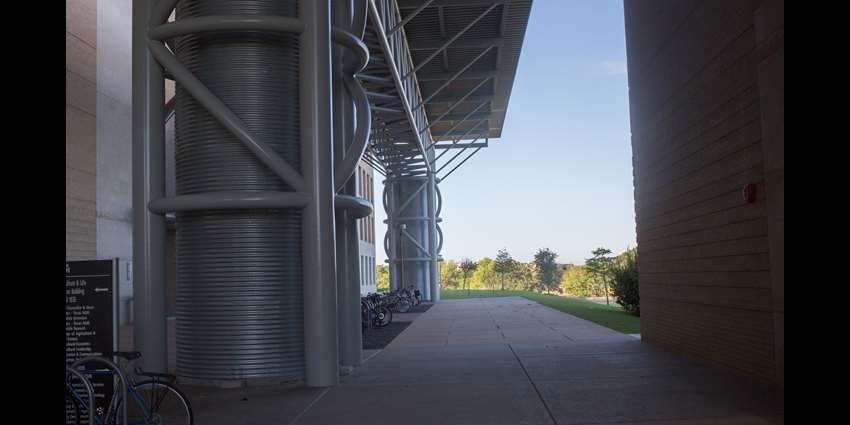Over the last decade, Texas A&M University has become a leader in water conservation and sustainability through its campus-wide rainwater harvesting strategies.
Rainwater harvesting, or the practice of capturing and collecting rainfall for reuse on-site instead of allowing it to runoff, is an effective strategy for reducing water use.
“This campus is doing some pretty great stuff as far as conservation,” said Don Crawford, resident regional director of grounds for SSC Service Solutions, the company Texas A&M contracts with for facilities services. “It has amongst its faculty some really leading-edge experts in the use of rainwater harvesting.”
Collecting water during rainy days is a practical strategy in Texas, where rainy periods are often followed by dry weather. “We don’t have to pump water out of the ground or get it from a reservoir, so in dry periods it makes a lot of sense,” Crawford said of rainwater harvesting.
Most designs use a building’s roof as a catchment for rainwater, which is piped down into a tank or holding reservoir. The water is then pumped out for irrigation purposes and supplemented with potable water as needed, he said.

There are eight rainwater cisterns in the College Station campus, ranging in capacity from a few thousand gallons to upward of 80,000 gallons. Each building uniquely incorporates its rainwater harvesting system, and the collected water is used to partially irrigate surrounding landscapes.
For example, the contractors who renovated the Memorial Student Complex used an old grease trap and converted it to a cistern, Crawford said.
“All that hardware and equipment is integral to the building,” he said. “They’ve been creative in how they use them.”
On West Campus, the student-run Howdy Farm also uses two cisterns as a sustainable way to help water its gardens.
“The Howdy Farm was created out of a need for students to not only get their own hands-on experience in what they were learning in the classroom and put it to use but to take charge of their own projects,” said Corey Wahl, the farm’s manager.
One intern took the initiative and hooked up an existing rainwater tank to the farm’s irrigation system. The other tank was funded by an Aggie Green Fund grant.
The combined storage of the tanks is 2,000 gallons, which serves one small garden, as well as plants that can’t tolerate the high pH of municipal water, such as blueberries and seedlings, Wahl said.
The salt concentration in local water, which comes from the Carrizo-Wilcox Aquifer, is another concern for all campus irrigation sites. “Any amount of freshwater that doesn’t have this high salt is going to help,” Crawford said. “Excess salt is not good for plants.”
Salty water can be particularly problematic when it is used to irrigate on tightly packed soil, such as the soil type found on campus, as it binds to the soil and further prevents water penetration. “You can make pottery out of the clay around here,” he said, jokingly.
“By using rainwater, you can push the salt through the profile and it does have some effect of loosening up that soil,” he said. “From a horticultural standpoint, it’s a beautiful thing.”
Since the rainwater is not used as drinking water, it only requires initial filtering before being pumped for irrigation.

Texas state building codes now require a rainwater harvesting system on every new state building of a certain size, such as on public university campuses, so Aggies can expect to see more cisterns in the future. Some of the more highly anticipated new rainwater harvesting sites will be in The Gardens at Texas A&M, which are scheduled to be completed in the fall of 2017.
The gardens began as a vision of Dr. Mark Hussey, vice chancellor and dean of the College of Agricultural and Life Sciences, to create a public garden on Texas A&M’s West Campus that would serve as a sanctuary and outdoor classroom for students and faculty.
“Our goal is two-fold. One is to create the premier teaching garden in the nation,” said Dr. Doug Welsh, The Garden’s program coordinator and a veteran horticulturist and Texas A&M professor emeritus. “Two, as far as sustainability, is to make it the outdoor oasis for Texas A&M students.”
The Gardens will use the already existing rainwater harvesting site in the Agricultural and Life Sciences building, which stores 80,000 gallons, to channel the water to the rose garden and other nearby areas.
One of the new sites will be used to irrigate a rain garden. Another will be constructed next to a farm stand and serve as an educational tool and resource for those interested in smaller scale, residential rainwater harvesting.
The entire garden will be plumbed to allow for opportunities to add more rainwater sites in the future, Welsh said.
“Even with the amount of rainwater we have, it’s still a token amount to irrigate The Gardens completely,” he said. “But there are always strategies.”
The planners are also considering blending the rainwater with the municipal water to dilute the latter’s sodium concentration and increase the amount of water available for irrigation.
As Texas A&M and its water needs continue to grow, rainwater harvesting will become especially critical for irrigating landscapes and gardens, Crawford said.
“Some people argue that if everyone collected rainwater we wouldn’t have enough going into the groundwater,” Wahl said. “But in Texas especially, we get major downpours, and a lot of the water doesn’t have time to soak into the ground, it just goes into storm drains and waterways.”
Despite the costs of rainwater harvesting infrastructure, Crawford views building and maintaining rainwater harvesting sites as a necessary effort.
“Water’s going to be gold,” he said. “And in some parts of the world, water is gold. This is an arid part of the country, and we have to squeeze every ounce that we can.”
The campus buildings that currently have cisterns are:
- Agricultural and Life Sciences Complex
- Memorial Student Center
- Mitchell Physics
- Liberal Arts and Arts & Humanities
- Hullaballoo Hall
- Physical Education Activity Program
- Interdisciplinary Life Science
- Joint Library (Riverside campus)
For more information on rainwater harvesting at Texas A&M, visit rainwaterharvesting.tamu.edu.

